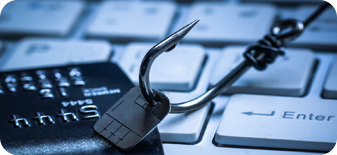![]()
Fake Text Messages from OAS FCU

What is it?
Text scams may involve a fake text that says it’s from OAS FCU and pretends to alert you to potential fraud or suspicious activity on a credit union account, like an unusual withdrawal or purchase. The text asks you to respond right away and either authorize or cancel the purchase. To watch a quick video on these types of scams, click here.

How does it work?
Once you respond to the text, you’ll receive a phone call from a person claiming to work at OAS FCU. They’ll typically ask for your login ID for Online Banking. Once they have that information, they’ll tell you that they texted you a security code to verify your identity.
However, the criminal actually used your security code to retrieve your password using the “forgot password” option in Online Banking. If you read that security code back to them, you give them the ability to access your account. Next, they’ll proceed to review recent transactions with you. When no issues are discovered (because no fraud has been committed yet), everything will seem fine. Then, they’ll ask you to confirm your debit card PIN and say they’ll be changing it to keep you safe and avoid any fraudulent transactions.

What are the consequences?
Because the criminal has your debit card PIN -which they didn’t actually change-, and access to your Online Banking, they can take your money using peer-to-peer (P2P) transfers. By the time you realize what happened, your money is gone.
Ignore it and call us immediately at 202-458-3834. If it appears to be from another organization you have a relationship with, contact them and report the fraud attempt directly.
Set up alerts in Online Banking so you’ll be notified by email or text if someone changes your password or an unauthorized transaction is performed. You can also use our CardNav app to receive instant notifications about Debit Card transactions and turn off your card in the event of fraud.
![]()
Phishing Scams

What is it?
Criminals use “phishing” emails to trick you into responding and gathering your personal and private information. Phishing sounds just like “fishing” because both use a lure or bait to try to get something on the hook. Criminals go “fishing” for victims through emails that may look official or genuine but aren’t. Don’t bite the hook. In this case, the hook is a link to a fake website full of viruses and harmful software. To watch a quick video on these phishing scams, click here.

How does it work?
The “bait” in an email phishing scam is the email itself. Criminals go to great lengths to ensure the email appears legitimate by using real people’s names, real logos, and language that sounds very official. The victim is often urged to “verify information” or “respond to an official request” by visiting a fake website and providing a username and password, account number, Social Security Number, or other sensitive data. Some victims are asked to download a form to review information.

What are the consequences?
If the victim takes the bait, the criminal can get access to accounts or obtain personal information to steal money, make purchases, apply for loans, or even sell that information on the dark web. The criminal could also try to lock you out of your own computer and demand that you pay a ransom to restore your access. This hacking technique, called Ransomware, is typically carried out through email phishing.
Be suspicious and look closely at the email without clicking any part of it. If it seems to be out of the ordinary, delete it.
Protect yourself by protecting your computer, smart phone and account information.

Protect your computer with security software. Set the software to update automatically so it can deal with any new security threats.

Protect your smart phone by setting software to update automatically. These updates may provide critical protection against security threats.

Protect your accounts by using multi-factor authentication. Some accounts offer extra security by requiring two or more credentials to log in to your account.

Never share your personal or account information with anyone.

Constantly monitor the activity on your accounts and your credit report
Imposter Scams

What is it?
Imposter scams take many forms. The criminal could impersonate a government agency, hospital, nonprofit, or other organization to commit fraud. They’ll contact you via email, phone, text, social media, or even send you mail or knock on your door. They often target the vulnerable, particularly the elderly, ill, or unemployed. Imposter scams are also referred to as social engineering. We have included a video as an overview of what to look out for that you can watch by clicking here.

How does it work?
The criminal may ask for personal or financial information so they can receive a payment, such as unemployment insurance, Social Security, or retirement funds. They might also pretend they’re from a charity and ask for a donation, transfer of funds, or prepaid debit card for support.

What are the consequences?
If an imposter obtains your personal or financial information, they can access your accounts, credit cards, mortgages, loans, and more, and take money from those accounts. They can also trick you into sending money to a bogus organization.
Always ask for identification and references from anyone asking for personal or financial information that you do not know.
Never share your personal or account information with anyone.

Always monitor the activity on your accounts and your credit report

Set up alerts in Online Banking and download the CardNav app to get notified about Debit Card transactions and turn off your card in the event of fraud
![]()
Malicious Mobile Apps

What is it?
Almost everyone who has a smartphone uses mobile apps such as OAS FCU Mobile, WhatsApp, Uber, and many others to manage their finances, stay in touch with loved ones, get rides, read the news, and much more. Unfortunately, these platforms and their users have also become targets for criminals. They create fake apps or “spoofs” and some of these fakes are even available in official app stores that credit union members mistakenly download and use.

How does it work?
When a fake mobile app is downloaded, the user will receive a notification that says the app requires or requests access to location history, calling information, photos, contacts, and other phone data and applications. This information can also be obtained through fake texts or emails.

What are the consequences
Once the criminal gains access to your information, they can use it to steal money, commit fraud and identity theft, and target additional victims through your contacts.
What you can do:
Before you download any apps, always check documentation and sources on your app store. If you want to download our app, please be sure to look for “OAS FCU Mobile App” in your app store.
![]()
Money Flipping

What is it?
Money flipping is typically a social media scam in which criminals contact you about “unclaimed funds.” Some scammers say they’ll help you turn or flip hundreds of dollars into thousands of dollars.

How does it work?
One money flipping technique involves someone asking for your Online Banking login credentials or a credit card number. Another method is to approach you with an investment opportunity. Criminals even create fake websites that show how easy it is for you to make money. Some will say they represent well-known companies or organizations, and if you send them a prepaid debit card, they’ll help you turn that small amount of money into a much larger payoff.
In both cases, criminals use social media to connect with you and build trust. They might even create fake accounts of friends or followers to fool you into trusting them.

What are the consequences?
Account numbers and Online Banking credentials are used to withdraw or transfer money out of your accounts. Some criminals will use fraudulent checks to deposit funds into your account and quickly withdraw them. Of course, if you send a prepaid card, they’ll just keep the money, and you’ll never hear from them again.
What you can do:
If it seems too good to be true, it probably is. Avoid them at all costs.
![]()
Money Mule Scams

What is it?
The “mule” part of this scam name comes from the fact that the criminal is trying to get you to carry something for them – like mules being used to carry heavy things.
In a money mule scam, criminals try to trick you into participating in an illegal transfer of funds in exchange for payment. A money mule scam often involves incredible or emotional stories to motivate you to participate and show your loyalty to an individual or group. In some cases, the criminal claims a soldier stuck overseas or the victim of a catastrophe needs help.

How does it work?
Criminals use social media, email, and phone calls to recruit participants. Money is then transferred to your account, whether this is an existing account or a new account created for these transfers, before reaching its final destination. Some victims don’t realize this activity is illegal.

What are the consequences?
Financial institutions, including OAS FCU, could see unusual or suspicious money transfers and contact you to investigate. If caught, you could face legal penalties for participating in this criminal activity.
What you can do:
Report it to the Federal Trade Commission (FTC) by calling 1-877-FTC-HELP (1-877-382-4357) or visiting ftc.gov/complaint.

Social Engineering